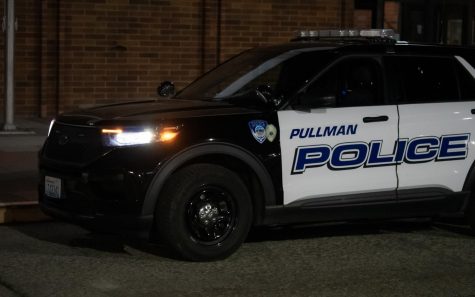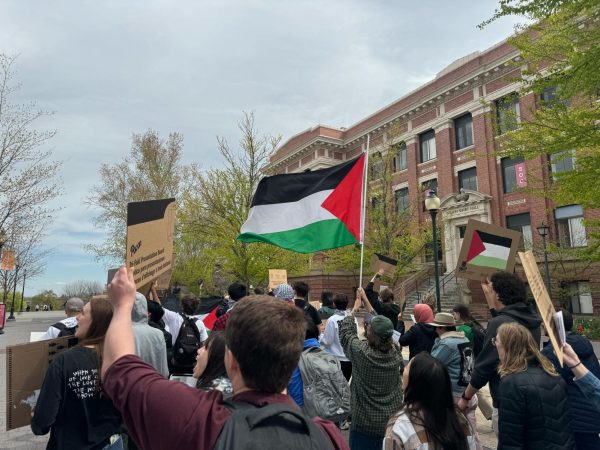Speaker addresses importance of physical activity
Certain elements can cause people to walk, use bicycle more
ABBEY ROSE | THE DAILY EVERGREEN
Mark Fenton, a public health, planning, and transportation consultant, discusses possible changes to Pullman roads that could make it safer for pedestrians, bikers, buses and cars Thursday at the Chinook Student Center.
April 19, 2019
A public health, planning, and transportation consultant talked about ways to make Pullman more biker- and pedestrian-friendly and the importance of it.
Mark Fenton said most Americans only walk 5,000 steps daily even though the recommendation is double that number. By taking part in moderate physical activity for 150 minutes per week, a person’s health risks decrease.
Walking for 30 minutes a day, even if that time is broken up throughout the day, five days a week is a great way to get started, he said. It decreases the risks for dementia, cardiovascular disease, type 2 diabetes, obesity, osteoporosis and certain cancers.
Only 5 percent of Americans actually do 150 minutes of physical activity weekly, he said.
“I think we have to stop talking about an obesity epidemic,” Fenton said. “Let’s talk about an epidemic of inactivity.”
Certain factors cause people to walk more, he said. One of those factors is whether communities have a variety of destinations close together.
Fenton said another element is that these places have sidewalks, trails, bike lanes or frequent transit to connect them.
People who use transit regularly get, on average, 30 minutes more exercise per day because they walk more using transit, he said.
Another factor is safety and accessibility. Roundabouts and curb extensions are safer and encourage bikers and pedestrians, he said.
He said it is beneficial to motivate others to try new things, such as trying the park and ride once a week or using a Coug bike when crossing campus.
Physical activity is made easier if a person has someone else’s support, Fenton said.
“You can be that voice,” he said.
That can be something as simple as asking someone to walk to a meeting instead of driving, Fenton said.
A way to both decrease traffic and become healthier is to not use a car for one trip each week, which would mean vehicles would be reduced by 20 percent on campus, he said.
There are ways to make towns friendlier to pedestrians and bikers, he said.
In Whitefish, Montana, Fenton said, he helped the city narrow an already-wide road to include a bike lane near a school. Originally, parents criticized the change, and would not let their children ride on the lane because of the tough winters or predators.
The city temporarily set up the bike lane with some cones and spray paint, and the children used it, he said.
“They proceeded to fill the schoolyard with bikes,” Fenton said. “I would argue that the trying, the temporary try, led them to be willing to do a more permanent infrastructure change.”
Research shows 60 percent of people would ride bikes more frequently if it were safer. He said cities should include more bike lanes, especially protected bike lanes, and create more multi-use trails.
One of the things Pullman can do is remove the on-street parking from Northeast North Fairway Road. That way, not only would bikers and pedestrians be safer, but also drivers because there would be no bicyclists on the street. It would be good to try it during the summer for a short time to see if it works, he said.
He said one of his ideas that might be “crazy” is to make the outside lanes on Stadium Way solely for transit and bikes.
Stadium Way would be made safer for bicyclists because drivers would not be trying to maneuver around them, Fenton said.
The best way to implement things like this is to try it, even if that means trying it on a Sunday during the summer, then try it for a weekend, then for a couple of weeks, he said.
“Really learn. Don’t just make … grandiose statements about why it can’t work. That’s easy,” Fenton said. “I don’t want to hear that. What I want to hear is, ‘We actually collected data, and here’s what we know, and here’s how we’d have to make it work better.’ ”
To make Pullman more friendly for bikers and pedestrians by changing the design of the community, he said, talk to people, most importantly community leaders, but also family, friends, students and media.
“We’re really counting on the next generation,” Fenton said, “to solve the problems we made through bad urban design and bad transportation choices.”





















